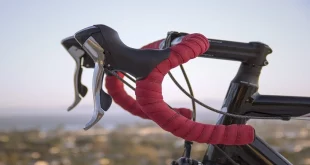Yes, punctured bicycle tires can still be used with caution, but it is not recommended for safety reasons. Punctured bicycle tires can be a frustrating inconvenience for riders.
Whether it’s a small nail or a piece of glass on the road, these unexpected punctures can quickly ruin a cycling experience. As an avid cyclist, you may be left wondering if you can still use your punctured bicycle tires.
The short answer is yes, but with caution. While it may be tempting to continue riding with a punctured tire, it is important to consider the potential risks and hazards it presents. In this article, we will explore whether it is safe to use punctured bicycle tires, the possible consequences, and alternative solutions that can get you back on the road with peace of mind. So, let’s dive in and find out if you should keep pedaling or opt for a quick repair.
Is It Safe To Ride On A Punctured Bicycle Tyre?
When it comes to cycling, a punctured bicycle tyre can be a frustrating and inconvenient occurrence. However, the question remains: is it safe to ride on a punctured bicycle tyre? Before deciding whether to continue riding with a punctured tyre, it’s important to consider a few crucial factors.
Let’s explore these factors and delve into the safety concerns and risks associated with riding on a punctured bicycle tyre.
Can You Continue Riding On A Punctured Bicycle Tyre?
Before hitting the road with a punctured tyre, it’s essential to evaluate the following factors:
- Severity of the puncture: First and foremost, consider the severity of the puncture. Is it a minor puncture or a more significant one? A minor puncture, such as a small thorn or a tiny nail, may only result in a slow leak. In such cases, it might be possible to ride a short distance before repairing or replacing the tyre. On the other hand, a large puncture or a sidewall cut can pose a higher risk, making it unsafe to continue riding.
- Tyre pressure: Another crucial factor to consider is the tyre pressure. Riding on a punctured bicycle tyre can lead to a rapid decrease in tyre pressure, affecting your ability to control the bike. Low tyre pressure can make the bike unstable, leading to decreased traction, difficulty in maneuvering corners, and an increased risk of accidents.
- Riding conditions: The condition of the road or trail you intend to ride on must also be taken into account. Riding on a punctured tyre on smooth, well-maintained roads might be less risky compared to off-road trails or rough terrain, where the chances of further damage to the tyre and potential loss of control are higher.
Safety Concerns And Risks Associated With Riding On A Punctured Bicycle Tyre
Riding on a punctured bicycle tyre poses several safety concerns and risks that can outweigh the convenience of continuing the ride. Here are a few notable risks:
- Loss of control: A punctured tyre can reduce your control over the bike. As the tyre loses air, stability and grip on the road decrease, making it challenging to handle the bike effectively, especially during turns or sudden maneuvers.
- Increased chance of accidents: With reduced control and stability, the risk of accidents escalates significantly. Unexpected wheel slips, decreased braking performance, and compromised handling can all contribute to a higher likelihood of accidents.
- Further damage to the tyre: Riding on a punctured tyre can exacerbate the damage and render it irreparable. The continued pressure and friction between the tyre and the road can lead to sidewall blowouts or complete tyre failure, leaving you stranded and potentially injured.
Considering the factors mentioned above, it is evident that riding on a punctured bicycle tyre is not advisable. While minor punctures may allow for short rides to safety, it is crucial to address the issue promptly to avoid unnecessary risks and potential accidents.
Always prioritize your safety and the integrity of your bicycle by promptly repairing or replacing a punctured tyre before hitting the road again. Stay safe, enjoy your ride, and remember to prioritize regular maintenance to prevent punctures in the first place.
Repair Options For Punctured Bicycle Tyres
Are you wondering what to do with a punctured bicycle tire? Don’t worry! With the right repair options, you can quickly get back on the road. In this section, we’ll explore the steps to repair a punctured bicycle tire and discuss the pros and cons of DIY repair versus professional repair services.
So let’s dive in and find the best solution for you!
Steps To Repair A Punctured Bicycle Tyre
If you prefer a DIY approach to repair your punctured bicycle tire, here are the steps you can follow:
- Start by removing the wheel from your bike frame.
- Deflate the tire completely to make it easier to locate the puncture.
- Inspect the tire thoroughly by visually checking and feeling for any sharp objects, such as glass or nails, causing the puncture.
- Once you’ve located the puncture, mark it for easier identification during the repair process.
- Use a tire lever to carefully remove the tire from the rim, ensuring you don’t damage the inner tube.
- Check the inner tube for any additional punctures, and if necessary, replace it with a new one.
- Apply a thin layer of rubber cement to the puncture area on the inner tube.
- Allow the rubber cement to dry for a couple of minutes, then use a patch kit to apply a patch over the punctured area.
- Press down firmly on the patch to ensure proper adhesion and remove any air bubbles.
- Before reassembling the tire, inflate the inner tube slightly to check for leaks.
- Finally, inflate the tire to the recommended pressure, reattach the wheel to your bike frame, and you’re ready to roll!
DIY Repair Vs. Professional Repair Services
Now that you know the steps to repair a punctured bicycle tire on your own, let’s consider the alternative option: professional repair services. Here are the key points to consider for each option:
DIY repair:
- Cost-effective, as you only need to invest in a patch kit and possibly an inner tube if it’s damaged.
- Gives you the satisfaction of fixing your own bike and acquiring hands-on skills.
- Convenient if you have the necessary tools and know-how readily available.
- Can be time-consuming, especially if you’re not familiar with the repair process.
- There may be a learning curve if you’re a beginner.
Professional repair services:
- Saves you time and effort as experts will handle the repair for you.
- Ensures a high level of expertise and accuracy in the repair process.
- May be necessary for more complex tire issues, such as sidewall damage.
- Comes at a cost, as professional services typically charge for their expertise and labor.
- Requires finding a reputable repair shop near you.
By considering these pros and cons, you can choose the repair option that aligns with your skills, resources, and preferences. Whether you decide to tackle the puncture repair yourself or opt for professional assistance, the most important thing is getting back on your bike as soon as possible.
Alternative Solutions For Riding With Punctured Bicycle Tyres
Temporary Fixes For Punctured Bicycle Tyres
When you’re out enjoying a ride on your bicycle, there’s nothing more frustrating than experiencing a punctured tyre. It can quickly put a damper on your plans and leave you wondering if you can still use your bicycle with a punctured tyre.
Fortunately, there are some temporary fixes that can get you back on the road in no time. Here are a few options to consider:
- Patch repair kit: One of the most common and convenient solutions is to use a patch repair kit. These kits usually include patches, glue, and sandpaper. Simply locate the puncture, roughen the area with sandpaper, apply glue, and place the patch over the hole. Allow the patch to dry before inflating the tyre.
- Inner tube replacement: If you have a spare inner tube, replacing the punctured tube can be a quick fix. You’ll need tire levers to remove the tyre, release the air pressure, and swap out the tubes. Ensure that the replacement tube is properly inflated before continuing your ride.
- Tyre boot: For larger cuts or gashes in the tyre, a tyre boot can provide temporary reinforcement. These boots are typically made of a durable material like a rubber or a piece of an old tyre. Place the boot between the tube and the compromised area of the tyre, ensuring it covers the hole. Inflate the tyre slowly to avoid dislodging the boot.
- Duct tape: In a pinch, duct tape can be a temporary fix for small punctures. Wrap several layers of duct tape around the affected area to create a barrier, preventing further air leakage. While this method may not be as durable as other solutions, it can buy you some time until you can make proper repairs.
Using Sealants And Tyre Liners To Prevent Punctures
Prevention is always better than cure, and there are products available that can help minimize the risk of punctures in the first place. Here are a couple of solutions worth exploring:
- Sealants: Tubeless sealants can be injected into the tyre, coating the inside and quickly sealing small punctures as they occur. These sealants are typically latex-based and can provide an extra layer of protection against future punctures. It is important to periodically check the sealant levels and replenish them when needed.
- Tyre liners: Tyre liners are flexible strips made of materials such as kevlar or polyurethane that are placed between the tyre and the tube. These liners act as a barrier between the road and the tube, reducing the likelihood of punctures from sharp objects. They are especially useful in areas with rough road conditions or debris.
Exploring Tubeless Tyre Options For Puncture Resistance
Another option to consider for enhanced puncture resistance is switching to tubeless tyres. Tubeless tyres remove the need for inner tubes, relying on a tight seal between the tyre and the rim to hold air. Here are some benefits of tubeless tyres:
- Puncture resistance: Sealants can be used in tubeless tyres to quickly seal punctures, providing an effective way to combat flat tyres on the go. Additionally, the absence of an inner tube eliminates pinch flats caused by impacting sharp edges or curbs.
- Lower rolling resistance: Tubeless tyres often have a lower rolling resistance compared to traditional clincher tyres. This can result in increased speed and efficiency, making your rides more enjoyable.
- Improved traction: With lower tyre pressures possible in tubeless setups, you can achieve increased traction and better handling on various terrains.
While converting to tubeless tyres may require specific rims and tyres designed for this system, it can be a worthwhile investment for cyclists looking for enhanced puncture resistance and overall performance.
So, the next time you find yourself with a punctured bicycle tyre, consider these alternative solutions to keep you pedaling with confidence. Whether it’s a temporary fix, sealants, tyre liners, or even going tubeless, there are options available to ensure that pesky puncture doesn’t ruin your ride.
Frequently Asked Questions Of Can You Still Use A Punctured Bicycle Tyres?
Can You Ride A Bike With A Punctured Tire?
Yes, you can ride a bike with a punctured tire, but it is not recommended. Riding with a punctured tire can cause further damage and lead to a blowout, making it unsafe. It’s best to repair or replace the tire before riding again.
How Do You Fix A Punctured Bicycle Tire?
To fix a punctured bicycle tire, you can start by locating the puncture and removing any debris. Then, use a patch kit or replace the inner tube. Inflate the tire and check for leaks before riding again.
What Are The Dangers Of Riding On A Bike With A Punctured Tire?
Riding on a bike with a punctured tire can be dangerous. It increases the risk of losing control, especially when going at higher speeds or making turns. It can also damage the rim and cause other components to wear out faster.
Conclusion
Despite its initial inconvenience, riding with punctured bicycle tires is not impossible, especially in certain situations. Temporary fixes like tire patches or inflation devices can get you back on the road quickly. However, it’s crucial to note that punctured tires should be replaced as soon as possible to ensure optimal safety and performance.
Regular maintenance, such as checking tire pressure and inspecting for any punctures, can help prevent sudden tire failure. Additionally, investing in high-quality tires with puncture-resistant technology can reduce the risk of punctures and provide a more reliable riding experience. Remember, although you may be able to use punctured bicycle tires temporarily, prioritizing your safety and taking proper care of your tires will ultimately ensure a smoother and more enjoyable cycling experience.
So, next time you face a punctured tire, assess the situation and make the best decision to keep riding on two wheels.
 CommutingLife Explore The World On Two Wheels
CommutingLife Explore The World On Two Wheels





